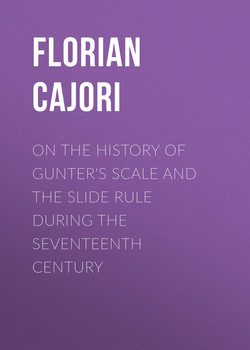On the History of Gunter's Scale and the Slide Rule during the Seventeenth Century

Реклама. ООО «ЛитРес», ИНН: 7719571260.
Оглавление
Florian Cajori. On the History of Gunter's Scale and the Slide Rule during the Seventeenth Century
I. INTRODUCTION
II. INNOVATIONS IN GUNTER’S SCALE
III. RICHARD DELAMAIN’S GRAMMELOGIA
V. INDEPENDENCE AND PRIORITY OF INVENTION
VI. OUGHTRED’S GAUGING LINE, 1633
VII. OTHER SEVENTEENTH CENTURY SLIDE RULES
Отрывок из книги
We begin with Anthony Wood’s account of Wingate’s introduction of Gunter’s scale into France.5
Gunter’s scale, which Wingate calls the “rule of proportion,” contained, as described in the French edition of 1624, four lines: (1) A single line of numbers; (2) a line of tangents; (3) a line of sines; (4) a line, one foot in length, divided into 12 inches and tenths of inches, also a line, one foot in length, divided into tenths and hundredths.
.....
This Mr. Milburn is probably the person named in the diary of the antiquarian, Elias Ashmole, on August 13 [1646?]; “I bought of Mr. Milbourn all his Books and Mathematical Instruments.”8 Charles Hutton9 says that Milburne of Yorkshire designed the spiral form about 1650. This date is doubtless wrong, for Thomas Browne who, according to Leybourn, got the spiral form of line from Milbourn, is repeatedly mentioned by William Oughtred in his Epistle10 printed some time in 1632 or 1633. Oughtred does not mention Milbourn, and says (page 4) that the spiral form “was first hit upon by one Thomas Browne a Joyner… the serpentine revolution being but two true semicircles described on severall centers.”11
Thomas Brown did not publish any description of his instrument, but his son, John Brown, published in 1661 a small book,12 in which he says (preface) that he had done “as Mr. Oughtred with Gunter’s Rule, to a sliding and circular form; and as my father Thomas Brown into a Serpentine form; or as Mr. Windgate in his Rule of Proportion.” He says also that “this brief touch of the Serpentine-line I made bold to assert, to see if I could draw out a performance of that promise, that hath been so long unperformed by the promisers thereof.” Accordingly in Chapter XX he gives a description of the serpentine line, “contrived in five (or rather 15) turn.” Whether this description, printed in 1661, exactly fits the instrument as it was developed in 1632, we have no means of knowing. John Brown says:
.....